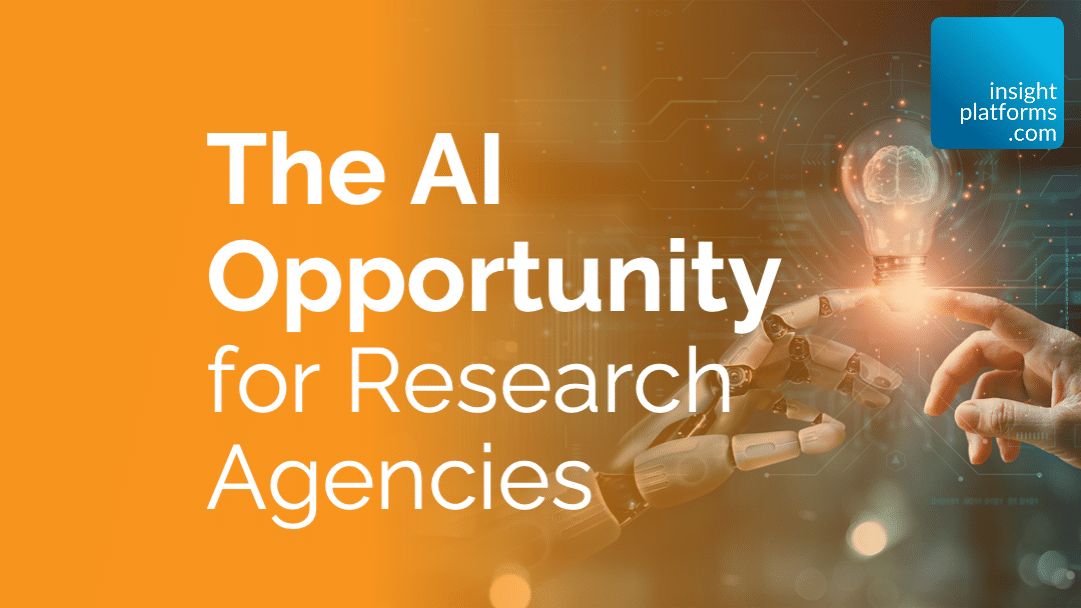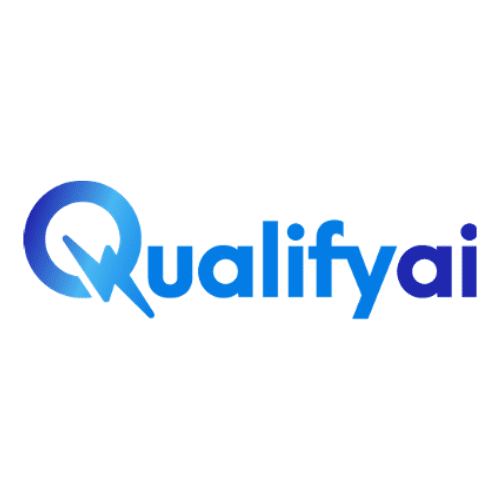
The AI Opportunity for Research Agencies
By Insight Platforms
- article
- Artificial Intelligence
- Machine Learning
- Generative AI
Without a shadow of doubt, Artificial Intelligence has been reshaping research methodologies and research technology. As these capabilities expand and improve, understanding the use, potential, and implications of AI in research and insights is essential for research agencies aiming to stay at the forefront of innovation.
Learn all about the the AI Tools Landscape in this on-demand masterclass:
AI Essentials: Navigating the Tools Landscape
Current Applications of AI in Research
AI’s integration into research is already quite widespread and encompasses various technologies designed to enhance data interpretation and decision-making processes:
- Text Analytics: AI-driven text analytics tools like Yabble help decipher complex patterns in large datasets, extracting themes and sentiments from diverse sources such as survey responses and social media.
- Social Listening: These tools (like Brandwatch) analyze social conversations to gauge public opinion and behaviors, which is crucial for understanding market trends and consumer preferences.
- Image Recognition/Analytics: AI-powered solutions (like YouScan) are adept at scanning images to recognize brands, and human activities, providing deeper insights into consumer behavior and brand visibility.
- Emotional Analytics (System 1): Technologies like Element Human and Affectiva interpret emotional responses from facial expressions, offering profound insights into consumer reactions to media or advertisements.
Adopting Generative AI in Research
The rise of Generative AI technologies marks a significant evolution in research capabilities, for example:
- Large Language Models (LLMs) like ChatGPT or Claude facilitate sophisticated text generation and conversation, enhancing qualitative research through simulated interactions.
- Image Generators such as Midjourney create visual content from textual descriptions, aiding in the conceptualization and testing of new ideas.
- Audio generator tools convert text to spoken word in various voices and accents, broadening the scope for multimedia content analysis
- Video generators leverage avatars and text prompts to produce video content, transforming how survey data and feedback are collected and presented.
Generative AI will benefit research agencies in four key areas:
- Research Design: AI tools like SurveyMind and Pollfish AI automate the creation and analysis of surveys and qualitative research platforms like Qualzy has embedded GenAI-powered assistants to come up with ideas for research projects, ultimately making research methodologies accessible to a wider audience. Image generation tools like DALL-E can help researchers create visual aids, concepts and other stimuli in a matter of seconds.
- Data Collection: Innovations such as video feedback integration (eg Voxpopme) and avatar-based interviewing (eg Fortell) promise to merge qualitative depth with quantitative breadth, enhancing data richness and empathetic understanding. Conversational survey tools (like inca) use AI to automate interactions and embed them in surveys to achieve a truly qualitative engagement. The newer GPT models are capable of supporting fully autonomous qualitative moderation.
- Data Creation: Predictive attention models such as Dragonfly AI or aimpower and synthetic data creation (see Yabble, Glimpse and Synthetic Users) offer new avenues to speed up and enhance the research process.
- Analysis/Reporting: AI’s ability to rapidly process and analyze both qual and quant datasets (like Coloop, SurveyMind or Inspirient) will streamline reporting, yielding quicker and more accurate insights.
Challenges & Opportunities for Research Agencies
In the short term, initial AI challenges include ensuring compliance with data privacy laws, maintaining accuracy to avoid generating misleading information, and being transparent about the algorithms and data sources used. In the medium and long term, there might be potential shifts in roles and team dynamics as AI tools become more integrated into workflows. Competitiveness will increase, and agencies might face a shift in client expectations toward DIY solutions.
On the other hand, the advent of AI in research opens several pathways for agencies. There’s an opportunity for learning and playing with these tools to understand how to integrate new technology into research methods effectively and in turn, reduce the time and costs associated with routine tasks. Starting conversations with clients about AI’s benefits can foster better relationships and service customization–most client-side researchers are looking for ways to integrate AI into their processes but face internal compliance and data security issues. However, they might be open to trying out new cutting-edge AI-powered solutions if agencies assume the risk.
Use Cases for New AI Technologies
Many innovative research agencies are grasping the AI nettle to drive efficiencies in their own business and to develop new value propositions for their clients. Here are just three examples.
Demoskop
Demoskop is an insights agency based in Sweden and best known for its advanced analytics, opinion polling and brand & comms measurement research.
At Demoskop, AI permeates the entire research process: from the design of questionnaires to advanced data analysis and image generation. We use AI to, for example, streamline processes, enhance our quality work, ensure data robustness, and work with fraud detection.
Stella is Demoskop’s in-house tool that integrates different generative AI systems and transforms complex data sets into clear insights and patterns. Its features are tailored to analysis and research workflows. This means that it can search internal databases, find patterns in data, and generate insights. It is a closed system to protect customer information and data.
The tool is unique flexible because Stella is not tied to a single language model or operating system and can therefore be adapted and updated without waiting for changes from external sources like Microsoft. This platform independence means that Stella works on any operating system—Windows, Mac, or Linux—while all data is securely stored with Demoskop.
Trinity McQueen
Trinity McQueen is a behaviour-led research consultancy based in the UK that helps clients create better products, communications and experiences.
Trinity McQueen’s intention with AI was to save time and effort, making it easier for them to write proposals and share knowledge. The main AI tool they use is called the “1-hour tender” which aims to help the agency with tender / proposal writing. They have uploaded 750k words of internal content from previous proposals, case studies, and proprietary thinking to train the language model.
The Q&A function helps take away the blank page when faced with a new tender and speeds the whole process up significantly. New hires at the company can create proposals in a remarkably short time by leveraging the detailed history and specifications of previous projects from the 25-year history of the company.
Trinity McQueen
Firefish
Firefish is a strategic, research-led consultancy that helps brands understand human motivations and behaviours.
Firefish developed its standalone QualifyAI product by working out all aspects of the qualitative research process that were labour-intensive without adding much value – and then automated them.
But Firefish has been clear about the need for humans to make QualifyAI work for clients. Their focus is on freeing up researchers’ time to focus on the insight and the project. QualifyAI automates the screening/sample process to deliver high-quality real people, runs AI-moderated conversations, uses AI for instant summaries, and sets up human strategists to feed in their expertise at the discussion guide and delivery stages.
“What was brilliant about Firefish’s QualifyAI tool was that I got the speed of AI, with the qualitative and strategic expertise of a senior Firefish consultant over the top. So, what we got back was not just an AI-generated summary of responses, but a sharp point of view and recommendation written by someone with deep expertise in both qualitative research and strategy. The whole process from briefing to output took less than 36 hours, and the report gave us the confidence and clarity to move forward.”
Global CMI Lead, Axe, Unilever
A Final Note
AI’s role in research is transformative and multifaceted, presenting both opportunities and challenges. Leveraging its power responsibly and creatively means that research agencies can enhance their offerings, streamline operations, and deliver deeper insights, securing a competitive edge in the rapidly evolving digital landscape. As we continue to explore AI’s potential, the symbiosis between human ingenuity and machine intelligence will potentially redefine the future of research and insights.






